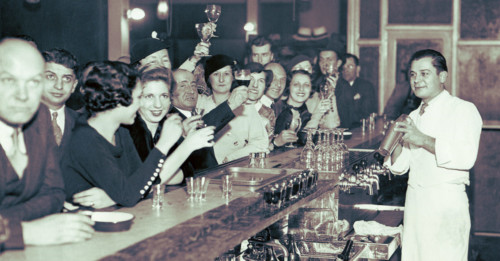They might look right at the top of a glass, but a tiny paper umbrella and a twist of orange peel do not a cocktail make. Nor does juice or soda when added to a shot of rum or vodka (if we’re gonna get really technical, these aren’t “cocktails” at all). So what exactly makes a cocktail? A few things—mainly spirits, water, sugar, and bitters. But also a lot of history.
Cocktails are traditionally thought of as an American innovation, but they were actually at least partly inspired by British punches—big bowls of spirits mixed with fruit juice, spices, and other flavors, consumed in punch houses in the 18th century. The term cocktail was even first seen in a British newspaper printed March of 1798. But the term wasn’t really defined as we know it until 1806, when The Balance and Columbian Repository of Hudson, New York, pinned the cocktail down to what we follow today: “a stimulating liquor composed of any kind of sugar, water and bitters, vulgarly called a bittered sling.” (The sling had actually predated the cocktail, basically the same thing made without bitters.)
“Stimulating” has always been a basic prime goal of cocktails, but the true art of bartending evolved thanks especially to one guy—Jerry Thomas. Jerry, aka “Professor” Thomas, a Connecticut-born, prolific American bartender who worked all over America and Europe and wrote one of the first comprehensive recipe books—The Bartender’s Guide (or How to Mix Drinks), basically an encyclopedia of mixed drinks that became a standard-bearer for bartenders.
Not that Thomas and his peers were working in a vacuum. Increasing travel and steps toward industrialization helped, as did innovations toward one key ingredient in cocktail culture: ice. Imagine going to a bar and getting everything from a Mint Julep to a Martini at dull room temperature. We don’t have to, thanks to a guy crazy enough to dream up an ice exporting business at a time when the fastest delivery system was a ship and most ports weren’t equipped to store whatever ice didn’t melt in transit. That didn’t deter Frederic “Ice King” Tudor, who kept trying and failing at hauling ice from colder climes to warmer ports until the venture finally succeeded (and made him a billionaire). With ice more available around the U.S. and internationally, the possibilities for cocktails—and cocktail consumption—exploded.
But then a little thing called Prohibition put a slight damper on cocktail consumption (and gave a big boost to organized crime). Even after it was repealed, many of our most talented bartenders had already found new homes abroad. In a sense, World Wars (and increased tourism) were a slight saving grace for cocktail culture, with exposure to the Pacific theater and its Polynesian culture introducing us to the kitsch and copious rums of what became our corrupted Tiki culture. Ernest Raymond Beaumont Gantt’s adopted Don the Beachcomber persona became an iconic Hollywood restaurant and Polynesian hot spot, while Victor Bergereon (aka “Trader Vic”) opened a self-named competing Tiki spot in San Francisco in the 1930s.
Attention to Tiki gave way to attention to other cocktail cultures, and by the mid-20th century, cocktail culture was on a slight upswing—think Mad Men, Manhattans, Martini lunches—only to take a step back as the drug cultures of the 60s and 70s strutted forward. It wasn’t until the 90s or thereabouts that a modest but ambitious group of bartenders led by people like Dale Degroff at New York’s famous Rainbow Room began reviving the classic cocktail culture of Thomas’s time, bringing historical values and strict quality standards back to a craft that had devolved into sour mix, pre-fab bottled cocktails like The Pink Squirrel, and shooters like the Training Bra. (The decades that followed Degroff saw what became a “mixology” renaissance.)
Classic and even historical cocktails might be more readily available, but many of the drinks found in The Bartender’s Guide probably won’t make their way to bar menus anytime soon—which is a shame, because they have fun names like Brandy Crusta and Port Wine Sangaree. So while you may not be able to order a Duke of Norfolk Punch (brandy, wine, milk, and sugar) at most bars, you may be able to get a decent Milk Punch or even (if you’re really lucky) watch a really skilled bartender pour liquid fire for Professor Thomas’s signature Blue Blazer. (Because liquid fire never goes out of style.)
